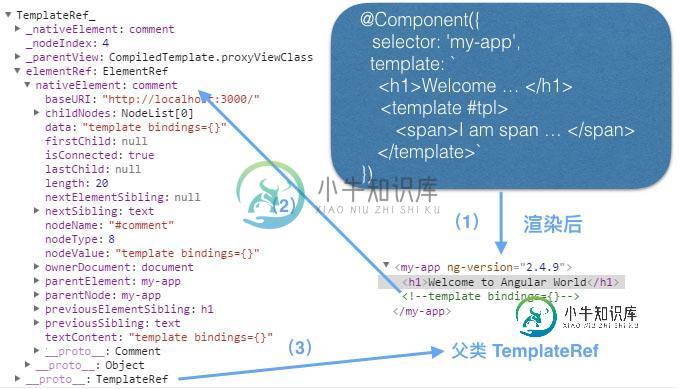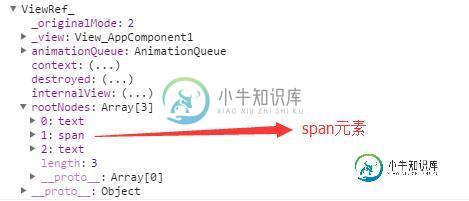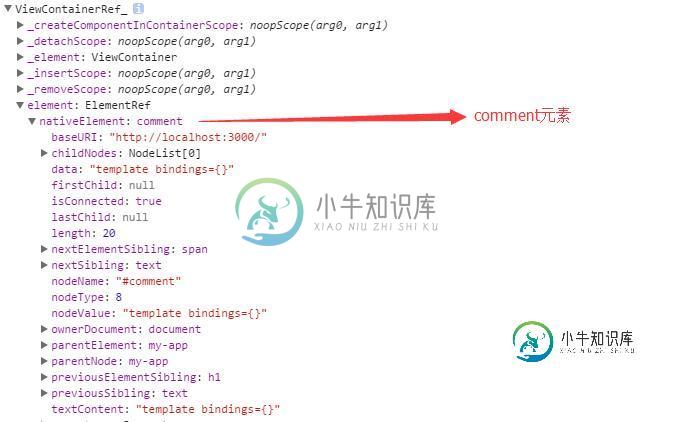Angular2学习教程之TemplateRef和ViewContainerRef详解
TemplateRef
在介绍 TemplateRef 前,我们先来了解一下 HTML 模板元素 - <template> 。模板元素是一种机制,允许包含加载页面时不渲染,但又可以随后通过 JavaScript 进行实例化的客户端内容。我们可以将模板视作为存储在页面上稍后使用的一小段内容。
在 HTML5 标准引入 template 模板元素之前,我们都是使用 <script> 标签进行客户端模板的定义,具体如下:
<script id="tpl-mock" type="text/template"> <span>I am span in mock template</span> </script>
对于支持 HTML5 template 模板元素的浏览器,我们可以这样创建客户端模板:
<template id="tpl"> <span>I am span in template</span> </template>
下面我们来看一下 HTML5 template 模板元素的使用示例:
<!DOCTYPE html> <html lang="en"> <head><meta charset="UTF-8"> <title>HTML5 Template Element Demo</title></head> <body> <h4>HTML5 Template Element Demo</h4> <!-- Template Container --> <div class="tpl-container"></div> <!-- Template --> <template id="tpl"> <span>I am span in template</span> </template> <!-- Script --> <script type="text/javascript"> (function renderTpl() { if ('content' in document.createElement('template')) { var tpl = document.querySelector('#tpl'); var tplContainer = document.querySelector('.tpl-container'); var tplNode = document.importNode(tpl.content, true); tplContainer.appendChild(tplNode); } else { throw new Error("Current browser doesn't support template element"); } })(); </script> </body> </html>
以上代码运行后,在浏览器中我们会看到以下内容:
HTML5 Template Element Demo I am span in template
而当我们注释掉 tplContainer.appendChild(tplNode) 语句时,刷新浏览器后看到的是:
HTML5 Template Element Demo
这说明页面中 <template> 模板元素中的内容,如果没有进行处理对用户来说是不可见的。Angular 2 中,<template> 模板元素主要应用在结构指令中,接下来我们先来介绍一下本文中的第一个主角 - TemplateRef:
import {Component, TemplateRef, ViewChild, AfterViewInit} from '@angular/core';
@Component({
selector: 'my-app',
template: `
<h1>Welcome to Angular World</h1>
<template #tpl>
<span>I am span in template</span>
</template>
`,
})
export class AppComponent {
name: string = 'Semlinker';
@ViewChild('tpl')
tpl: TemplateRef<any>;
ngAfterViewInit() {
console.dir(this.tpl);
}
}
上述代码运行后的控制台的输出结果如下:

从上图中,我们发现 @Component template 中定义的 <template> 模板元素,渲染后被替换成 comment 元素,其内容为 "template bindings={}" 。此外我们通过 @ViewChild 获取的模板元素,是 TemplateRef_ 类的实例,接下来我们来研究一下 TemplateRef_ 类:
TemplateRef_
// @angular/core/src/linker/template_ref.d.ts
export declare class TemplateRef_<C> extends TemplateRef<C> {
private _parentView;
private _nodeIndex;
private _nativeElement;
constructor(_parentView: AppView<any>, _nodeIndex: number, _nativeElement: any);
createEmbeddedView(context: C): EmbeddedViewRef<C>;
elementRef: ElementRef;
}
TemplateRef
// @angular/core/src/linker/template_ref.d.ts
// 用于表示内嵌的template模板,能够用于创建内嵌视图(Embedded Views)
export declare abstract class TemplateRef<C> {
elementRef: ElementRef;
abstract createEmbeddedView(context: C): EmbeddedViewRef<C>;
}
(备注:抽象类与普通类的区别是抽象类有包含抽象方法,不能直接实例化抽象类,只能实例化该抽象类的子类)
我们已经知道 <template> 模板元素,渲染后被替换成 comment 元素,那么应该如何显示我们模板中定义的内容呢 ?我们注意到了 TemplateRef 抽象类中定义的 createEmbeddedView抽象方法,该方法的返回值是 EmbeddedViewRef 对象。那好我们马上来试一下:
import {Component, TemplateRef, ViewChild, AfterViewInit} from '@angular/core';
@Component({
selector: 'my-app',
template: `
<h1>Welcome to Angular World</h1>
<template #tpl>
<span>I am span in template</span>
</template>
`,
})
export class AppComponent {
name: string = 'Semlinker';
@ViewChild('tpl')
tpl: TemplateRef<any>;
ngAfterViewInit() {
let embeddedView = this.tpl.createEmbeddedView(null);
console.dir(embeddedView);
}
}
上述代码运行后的控制台的输出结果如下:

从图中我们可以知道,当调用 createEmbeddedView 方法后返回了 ViewRef_ 视图对象。该视图对象的 rootNodes 属性包含了 <template> 模板中的内容。在上面的例子中,我们知道了 TemplateRef 实例对象中的 elementRef 属性封装了我们的 comment 元素,那么我们可以通过 insertBefore 方法来创建我们模板中定义的内容。
import { Component, TemplateRef, ViewChild, AfterViewInit } from '@angular/core';
@Component({
selector: 'my-app',
template: `
<h1>Welcome to Angular World</h1>
<template #tpl>
<span>I am span in template {{name}}</span>
</template>
`,
})
export class AppComponent {
name: string = 'Semlinker';
@ViewChild('tpl')
tpl: TemplateRef<any>;
ngAfterViewInit() {
// 页面中的<!--template bindings={}-->元素
let commentElement = this.tpl.elementRef.nativeElement;
// 创建内嵌视图
let embeddedView = this.tpl.createEmbeddedView(null);
// 动态添加子节点
embeddedView.rootNodes.forEach((node) => {
commentElement.parentNode
.insertBefore(node, commentElement.nextSibling);
});
}
}
成功运行上面的代码后,在浏览器中我们会看到以下内容:
Welcome to Angular World I am span in template
现在我们来回顾一下,上面的处理步骤:
- 创建内嵌视图(embedded view)
- 遍历内嵌视图中的 rootNodes,动态的插入 node
虽然我们已经成功的显示出 template 模板元素中的内容,但发现整个流程还是太复杂了,那有没有简单地方式呢 ?是时候介绍本文中第二个主角 - ViewContainerRef。
ViewContainerRef
我们先来检验一下它的能力,然后再来好好地分析它。具体示例如下:
import { Component, TemplateRef, ViewChild, ViewContainerRef, AfterViewInit } from '@angular/core';
@Component({
selector: 'my-app',
template: `
<h1>Welcome to Angular World</h1>
<template #tpl>
<span>I am span in template</span>
</template>
`,
})
export class AppComponent {
name: string = 'Semlinker';
@ViewChild('tpl')
tplRef: TemplateRef<any>;
@ViewChild('tpl', { read: ViewContainerRef })
tplVcRef: ViewContainerRef;
ngAfterViewInit() {
// console.dir(this.tplVcRef); (1)
this.tplVcRef.createEmbeddedView(this.tplRef);
}
}
移除上面代码中的注释,即可在控制台看到以下的输出信息:

而在浏览器中我们会看到以下内容:
Welcome to Angular World I am span in template
接下来我们来看一下 ViewContainerRef_ 类:
// @angular/core/src/linker/view_container_ref.d.ts
// 用于表示一个视图容器,可添加一个或多个视图
export declare class ViewContainerRef_ implements ViewContainerRef {
...
length: number; // 返回视图容器中已存在的视图个数
element: ElementRef;
injector: Injector;
parentInjector: Injector;
// 基于TemplateRef创建内嵌视图,并自动添加到视图容器中,可通过index设置
// 视图添加的位置
createEmbeddedView<C>(templateRef: TemplateRef<C>, context?: C,
index?: number): EmbeddedViewRef<C>;
// 基 ComponentFactory创建组件视图
createComponent<C>(componentFactory: ComponentFactory<C>,
index?: number, injector?: Injector, projectableNodes?: any[][]): ComponentRef<C>;
insert(viewRef: ViewRef, index?: number): ViewRef;
move(viewRef: ViewRef, currentIndex: number): ViewRef;
indexOf(viewRef: ViewRef): number;
remove(index?: number): void;
detach(index?: number): ViewRef;
clear(): void;
}
通过源码我们可以知道通过 ViewContainerRef_ 实例,我们可以方便地操作视图,也可以方便地基于 TemplateRef 创建视图。现在我们来总结一下 TemplateRef 与 ViewContainerRef。
TemplateRef:用于表示内嵌的 template 模板元素,通过 TemplateRef 实例,我们可以方便创建内嵌视图(Embedded Views),且可以轻松地访问到通过 ElementRef 封装后的 nativeElement。需要注意的是组件视图中的 template 模板元素,经过渲染后会被替换成 comment 元素。
ViewContainerRef:用于表示一个视图容器,可添加一个或多个视图。通过 ViewContainerRef 实例,我们可以基于 TemplateRef 实例创建内嵌视图,并能指定内嵌视图的插入位置,也可以方便对视图容器中已有的视图进行管理。简而言之,ViewContainerRef 的主要作用是创建和管理内嵌视图或组件视图。
我有话说
1.Angular 2 支持的 View(视图) 类型有哪几种 ?
- Embedded Views - Template 模板元素
- Host Views - Component 组件
1.1 如何创建 Embedded View
ngAfterViewInit() {
let view = this.tpl.createEmbeddedView(null);
}
1.2 如何创建 Host View
constructor(private injector: Injector,
private r: ComponentFactoryResolver) {
let factory = this.r.resolveComponentFactory(AppComponent);
let componentRef = factory.create(injector);
let view = componentRef.hostView;
}
2.Angular 2 Component 组件中定义的 <template> 模板元素为什么渲染后会被移除 ?
因为 <template> 模板元素,已经被 Angular 2 解析并封装成 TemplateRef 实例,通过 TemplateRef 实例,我们可以方便地创建内嵌视图(Embedded View),我们不需要像开篇中的例子那样,手动操作 <template> 模板元素。
3.ViewRef 与 EmbeddedViewRef 之间有什么关系 ?
ViewRef 用于表示 Angular View(视图),视图是可视化的 UI 界面。EmbeddedViewRef 继承于 ViewRef,用于表示 <template> 模板元素中定义的 UI 元素。
ViewRef
// @angular/core/src/linker/view_ref.d.ts
export declare abstract class ViewRef {
destroyed: boolean;
abstract onDestroy(callback: Function): any;
}
EmbeddedViewRef
// @angular/core/src/linker/view_ref.d.ts
export declare abstract class EmbeddedViewRef<C> extends ViewRef {
context: C;
rootNodes: any[]; // 保存<template>模板中定义的元素
abstract destroy(): void; // 用于销毁视图
}
总结
Angular 2 中 TemplateRef 与 ViewContainerRef 的概念对于初学者来说会比较羞涩难懂,本文从基本的 HTML 5 <template> 模板元素开始,介绍了如何操作和应用页面中定义的模板。然后通过实例介绍了 Angular 2 中 TemplateRef 和 ViewContainerRef 的定义和作用。希望通过这篇文章,读者能更好的理解 TemplateRef 与 ViewContainerRef。
好了,以上就是这篇文章的全部内容,希望本文的内容对大家的学习或者工作能带来一定的帮助,如果有疑问大家可以留言交流,谢谢大家对小牛知识库的支持。
-
本文向大家介绍Perl学习教程之单行命令详解,包括了Perl学习教程之单行命令详解的使用技巧和注意事项,需要的朋友参考一下 前言 本文主要给大家介绍了关于Perl单行命令的相关内容,分享出来供大家参考学习,下面话不多说了,来一起看看详细的介绍吧。 与One-Liner相关的perl参数 -a 自动分隔模式,用空格分隔$并保存在@F中,也就是@F=split //, $ -F 指定-a的分隔符 -l
-
本文向大家介绍Python 学习教程之networkx,包括了Python 学习教程之networkx的使用技巧和注意事项,需要的朋友参考一下 networkx是Python的一个包,用于构建和操作复杂的图结构,提供分析图的算法。图是由顶点、边和可选的属性构成的数据结构,顶点表示数据,边是由两个顶点唯一确定的,表示两个顶点之间的关系。顶点和边也可以拥有更多的属性,以存储更多的信息。 对于netwo
-
本文向大家介绍ES6学习教程之模板字符串详解,包括了ES6学习教程之模板字符串详解的使用技巧和注意事项,需要的朋友参考一下 模板字符串(template strings) ES6 中引进的一种新型的字符串字面量语法 - 模板字符串。书面上来解释,模板字符串是一种能在字符串文本中内嵌表示式的字符串字面量。简单来讲,就是增加了变量功能的字符串。 ES6为我们提供了模板字符串,语法使用反引号`。模板字符
-
本文向大家介绍ES6学习教程之对象字面量详解,包括了ES6学习教程之对象字面量详解的使用技巧和注意事项,需要的朋友参考一下 前言 本文主要给大家介绍了关于ES6对象字面量的相关内容,分享出来供大家参考学习,下面话不多说了,来一起看看详细的介绍吧。 ECMAScript6使得声明对象字面量更加简单,提供了属性简写和方法简写功能,属性名计算的新特性。 如果可以理解上述三个新特性,可以不必往下阅读。下面
-
本文向大家介绍spring学习教程之@ModelAttribute注解运用详解,包括了spring学习教程之@ModelAttribute注解运用详解的使用技巧和注意事项,需要的朋友参考一下 本文主要给大家介绍了关于java中@ModelAttribute使用的相关资料,分享出来供大家参考学习,下面来一起看看详细的介绍: 一、@ModelAttribute注释方法 例子(1),(2),(3)类似
-
本文向大家介绍socket.io学习教程之深入学习篇(三),包括了socket.io学习教程之深入学习篇(三)的使用技巧和注意事项,需要的朋友参考一下 前言 socket.io提供了基于事件的实时双向通讯,本文深入的介绍了socket.io,下面来看看详细的内容吧。 静态文件 socket.io默认情况下会通过socket.io-client包提供socket.io.min.js和socket.i

